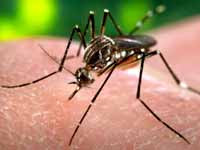SINGAPORE, Oct 14 — The number of people in hospital for Influenza A (H1N1) in Singapore is down to six, but there are troubling signs that a second wave could be gathering.
Polyclinic attendances are creeping up, and patients with upper respiratory tract infections hit more than 13,000 for the past two weeks, up from more than 11,000 early last month. Asked if this could signal the start of a second wave of the virus here, the head of the Communicable Disease Centre (CDC), Associate Professor Leo Yee Sin, said: “It may.”
Although the percentage of patients with influenza-like illness has dropped to 16 per cent, Singapore is closely monitoring the situation, she added.
With the northern hemisphere winter nearing, countries like the United States, Mexico and Britain are starting to see an expected resurgence of H1N1, with cases climbing rapidly.
Dr Wong Sin Yew, an infectious diseases physician in private practice and former head of the CDC, said although it was hard to say for certain if a fresh surge in H1N1 cases was occurring, the increasing numbers around the world is an indication of its inevitability.
“The writing is on the wall,” he said.
In the northern hemisphere, the outbreaks have been mild, though the increase is coming earlier than the traditional winter flu season, which raises concern that the numbers may soar in coming months.
Singapore has traditional peaks for seasonal flu from May to June and December to January.
General practitioners told The Straits Times they had seen a slight increase in the number of patients with flu-like symptoms.
But Dr Vincent Chia, deputy director of Healthway Medical, said this could also be due to the recent rainy weather or the current school examination period, when more students tend to fall ill.
At the peak of the H1N1 outbreak in August, the number of people hospitalised with the virus was 74.
Polyclinic attendances were at 24,477 a week, compared to 13,496 last week. Almost all the influenza cases now are likely to be H1N1.
At a press conference yesterday, Leo said data from more than 100 H1N1 patients showed that only one in two had a temperature of more than 38.1 degrees Celsius, so fever is not the only indicator of H1N1.
She urged that those in the high-risk group receive Tamiflu if they have flu-like symptoms but not a high fever.
She also urged children, pregnant women, and those who were obese or had underlying conditions to go for the seasonal flu and H1N1 vaccinations, when they are available in the coming weeks.
On another matter, infectious diseases experts from four public hospitals have come together for the first time to collaborate on two clinical studies.
One will study if a higher dosage of anti-viral drug Tamiflu is effective for some patients, especially those who are overweight.
The other will study if dengue patients whose blood platelet count drops to below 20,000 per ml, compared to the normal count of 150,000 to 450,000 per ml, will benefit from a platelet transfusion. — The Straits Times
Second wave of H1N1 outbreak emerging in Taiwan 14th October 2009
TAIPEI, Taiwan -- The Centers for Disease Control (CDC) warned Wednesday that a second wave of the influenza A (H1N1) outbreak is emerging in Taiwan after the previous one peaked in early September.
According to CDC Director-General Steve Kuo, the H1N1 situation has been moderating over the past five weeks since the previous peak but a slight jump in the number of patients diagnosed with the new flu strain recently signals the beginning of the second wave.
Statistics released Wednesday by the Central Epidemic Command Center (CECC) show that there was one more patient hospitalized with the H1N1 flu strain than a day earlier, bringing to 355 the total number of such cases since the outbreak began.
While 16 of the patients remained in the hospital, 315 had recovered and been discharged, and 24 others had died, the CECC said.
Meanwhile, 442 classes in 294 schools around the country remained suspended because of H1N1 infections among students. The number of affected classes accounted for 0.29 percent of the total, according to the CECC.
Although epidemiologists have predicted that the second peak would appear in November, Department of Health (DOH) Minister Yaung Chih-liang said it is hard to predict when the peak will be and that the DOH will continue to monitor the situation closely.
To help the public prepare for the epidemic, the DOH will distribute 5 million masks in inventory to 100,000 low-income families beginning Nov. 1, Yaung said.
Also, the CECC is expected to make public details regarding its H1N1 vaccination program on Oct. 20, when the results of human clinical trials for the H1N1 vaccine produced by local vaccine manufacturer Adimmune Corp. are expected to be released, DOH Deputy Minister Chang Shen-chwen said.
While people under 10 years of age will probably have to receive two shots, those aged 10 years and older will likely need only one to be protected against the disease, Chang said.
The number of schools in Japan closed because of the swine flu pandemic nearly doubled by Oct. 10 from a week earlier, according to figures from the Ministry of Health, Labor and Welfare.
School Closures At The Highest Due To Influenza A(H1N1) In Japan
Almost 6,480 schools, kindergartens and day-care centers were fully or partially closed because of the influenza outbreak, the report said. Tokyo had the highest number, with 752 schools affected last week. Japan had 52,956 schools and kindergartens in May this year, according to the Education Ministry.
School closures are at the highest since January 2000 when 4,131 schools were closed, said Takeshi Enami, Deputy Director of the division of infectious diseases at the Ministry of Health, Labor and Welfare.
There were 3,403 educational centers closed between Sept. 27 and Oct. 3, according to another report from the ministry.
More than 15,000 cases of swine flu have been confirmed in Japan, according to the Infectious Disease Surveillance Center. There were 24 deaths as of Oct. 14, according to the health ministry Web site. Of those, six were under the age of 20.
Many schools are closed in Japan during the flu season, the ministry said on its web site. Schools may be required to close if they are in an infected area, even if no students or staff develop flu symptoms, according to the ministry.
NOTE:-
The WHO, which declared H1N1 a global pandemic in June, says a third of the world`s population of nearly 7 billion people could catch it.
Earth becoming a disease hot spot : The warming earth is making us sick. Rising temperatures, frequent floods and prolonged droughts are ideal conditions for infectious diseases to spread. "Global warming is fuelling epidemics in areas which are unprepared. We're seeing the emergence of new diseases around the world. Old diseases are also coming back with a vengeance," Climate change has dramatically changing infection trends.
DENGUE DEATH CASES INCREASES BY 65% IN 2010
SAVE THE WORLD - STOP GLOBAL WARMING

Either You're With Me or You're Against Me in Stopping Global Warming!
Global Warming Articles
Let's Go Green & Save The World : Mentor Gemilang
The Truth Hurts - Truth is such a rare thing, it is delighted to tell it.

You can fool some of the people all of the time, and all of the people some of the time, but you can not fool all of the people all of the time.
Most truths are so naked that people feel sorry for them and cover them up, at least a little bit.
Truth always rests with the minority, and the minority is always stronger than the majority, because the minority is generally formed by those who really have an opinion, while the strength of a majority is illusory, formed by the gangs who have no opinion
Let's Go Green - Mentor Gemilang 1 - Visitors from 90 Countries
LATEST NEWS
Are u protected against Influenza A(H1N1)?
Repentance (At Taubah)
We can never be perfect since even prophets have at times made mistakes. Repentance means to abandon one's rebelliousness and arrogance before God and to stop deliberately disregarding His commandments without feeling any shame. Repentance also means to humbly hope for the mercy of God and to fear His judgment while doing the best one can to fulfill divine wishes within the limits of one's human weaknesses.


